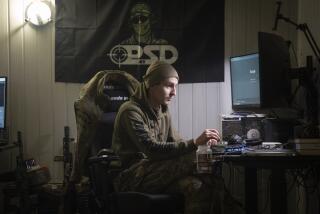U.S. Forces Know Their Enemy
- Share via
WASHINGTON — Like robbers who had cased a bank, the Navy SEALs who climbed silently onto two Iraqi oil terminals in the Persian Gulf in the small hours of Friday did not hesitate.
They knew what guards would be sitting where, which buildings were most crucial to seize and how to shut off the electricity. Certain of where to tether their quiet, high-speed jet boats and of which door to break through first, the commandos operated with stealth and precision to overwhelm the lightly armed Iraqi guards in minutes.
With the facility in U.S. hands, the Pentagon’s fears that Iraq would release millions of gallons of oil into the gulf -- or even blow up the terminals, 25 miles off the coast -- were allayed.
The key to the operation, said one Navy official, was “exquisite knowledge.” But for the U.S. military, such data are hardly in short supply. All over Iraq in the last few days, soldiers, sailors and airmen have been employing what may be the Pentagon’s most potent weapon: its deep knowledge of the enemy, accumulated in the 12 years since the Persian Gulf War.
“The Gulf War and everything we’ve learned after has given us a new window into the regime’s thinking and very explicit knowledge we didn’t have before,” one military official said. “What [Army Gen.] Tommy Franks used to formulate his war plan was an increasing understanding of what Saddam Hussein and his leadership would do.”
In the case of the oil terminals, the SEALs got help from intelligence gathered for years from satellite imagery, combined with data from low-flying surveillance planes that provided information on daily activities at the facilities where Iraq once pumped millions of barrels of crude a day.
The SEALs also benefited from “situational awareness” developed through the Navy’s work enforcing U.N. sanctions on Iraq, the Navy official said. That, “combined with specific intelligence gleaned in the days prior to this operation ... enabled these SEALs to see this operation before they actually executed it.”
Throughout Iraq, that kind of detailed knowledge has been making the difference for U.S. forces, officials say:
* In western Iraq, where Hussein’s forces launched missiles at Israel 12 years ago, U.S. forces knew where missile launch systems were and seized them before they could be used. Israel has suffered no missile strikes.
* In southern Iraq, months of psychological profiling gave U.S. ground forces advancing toward Baghdad a good idea of whether Iraqi army units they encountered would surrender or resist.
* In Baghdad, U.S. operatives who infiltrated the city months ago helped feed the Pentagon the intelligence used to plot the initial strikes aimed at Hussein and his lieutenants.
* From the secure Pentagon war room known as the Tank to the battlefield tents of commanders, there are scores of people who fought in the Gulf War and learned from the experience.
“Any corporation would kill to have people in their organization for 12 years -- and who have that kind of knowledge base -- move up the ranks the way today’s U.S. military has,” said retired Army Lt. Gen. William “Gus” Pagonis, who directed military logistics during the Gulf War. “We documented the Gulf War more than any other war in our history. We published everything we did, and how you do it and how you don’t do it. And for the last 12 years people have been taking it all in.”
Much of what the U.S. knows about Iraqi military capabilities, forces and terrain it has learned from years of patrolling the southern and northern “no-fly” zones, established to shield Iraqi Kurds and Shiite Muslims from Hussein’s forces. Military intelligence officials also have spent years gathering information from Iraqi defectors and analyzing seized documents.
“After the Gulf War we interrogated Iraqi commanders and we learned about their doctrine, how they launched weapons of mass destruction. We met a lot of people,” one military intelligence official said. “We got to go through a lot of documents that established a huge database, and we obviously picked up documents over time from the U.N. [weapons] inspectors and from defectors.”
In the case of the missile sites in western Iraq, defectors in recent years have helped U.S. intelligence agents narrow down the locations of the sites by telling them how long it took to drive there from their bases and what roads they used.
Using that knowledge, the U.S. sent surveillance planes, including unmanned Predators, to patrol the suspected sites.
“We learned about the capabilities of their launch systems, how long it took to get to them, what buttons to punch to work them, what roads to take off the main roads to get to them, how many miles and hours they normally traveled and for how long,” the military intelligence official said.
Using digital terrain imagery developed through years of surveillance, the Pentagon has been able to develop detailed maps of what U.S. ground forces may encounter in Iraq as they advance.
“I’m sure we know not just where there are mountains and where there are forests but where there’s a ridgeline that’s 10 meters higher than the valley next to it, because that ridgeline can keep you dry in a flood,” said Michael O’Hanlon, a military analyst at the Brookings Institution in Washington.
Now, after years of compiling such detailed information, the military has a chance to use it.
“You’ve already done a war and you know when they will launch [weapons of mass destruction], you know how they do it and you have a pretty good idea of where they hide it,” one military intelligence official said. “Ultimately what you’re going to be seeing over the next several weeks is: How well did we really learn Iraq?”
More to Read
Sign up for Essential California
The most important California stories and recommendations in your inbox every morning.
You may occasionally receive promotional content from the Los Angeles Times.










